Country / Region
AD-WAN Solution
The rapid development and large-scale deployment of cloud computing have transformed enterprise IT from traditional data centers to cloud computing data centers. However, this process will not change the requirements of users for fast and secure application experiences and cloud applications. The traditional WAN architecture is complex, difficult to expand, and enclosed and rigid, making it difficult to adapt to cloud computing demands. Therefore, the WAN architecture needs to be reshaped.
H3C Application-driven Wide Area Network (AD-WAN) is a standard SDN network architecture, which is a converged, layered and open network architecture. By combining intelligent network management, intelligent control, and intelligent analysis in a unified manner, a converged network control center and smart brain will achieve comprehensive network coverage, end-to-end network and service automation, visualization, and refinement of network management that integrates management, control, and analysis. It is user-oriented with unified portals, to truly fulfill "one login, one-click issuance, overall protection, one-station O&M".
• The Unified Digital Platform is the H3C digital network engine and the brain of the entire network. It is built based on containerized platform and service-oriented software architecture, providing users with data center, campus and WAN multi-scenario services. It also provides standard RestAPI northbound interfaces to introduce different OSS/BSS management systems in a more open and flexible way and accelerate business innovation. It provides extensive standard southbound protocols to connect with the device layer, such as SNMP, NETCONF, Telemetry, thus realizing the management, control, and analysis of devices.
• Management: It provides traditional management capabilities such as device version management, configuration management, alarms, performance, topology, and other value-added service capabilities such as QOS.
• Control: It provides zero touch provisioning (ZTP), WAN optimization, network traffic tuning and other functions to prioritize the service need protection.
• Analysis: Telemetry technologies are used to identify network status rapidly and realize second-level O&M. It shows users the most critical value elements in the displayed network to facilitate O&M. The analysis service applies AI to O&M services, collects network-wide information, including network equipment, traffic, quality, associated events and alarms, etc. Underpinned by big data and AI technologies, machine learning and deep analysis algorithms, the solution monitors networks from the perspective of applications and identifies network and application failures in a proactive manner. It provides automated troubleshooting capabilities for network and service issues, helping users quickly locate faults. It reduces O&M costs and improves the competitiveness of enterprise products.
Benefits
Features
Zero touch provisioning (ZTP)
The AD-WAN solution provides a variety of zero touch provisioning (ZTP) capabilities to support unified configuration distribution and O&M management after devices come online automatically, requiring no professional O&M engineers at the front-end. It frees network administrators from tedious provisioning and O&M pressure, and reduces labor costs.
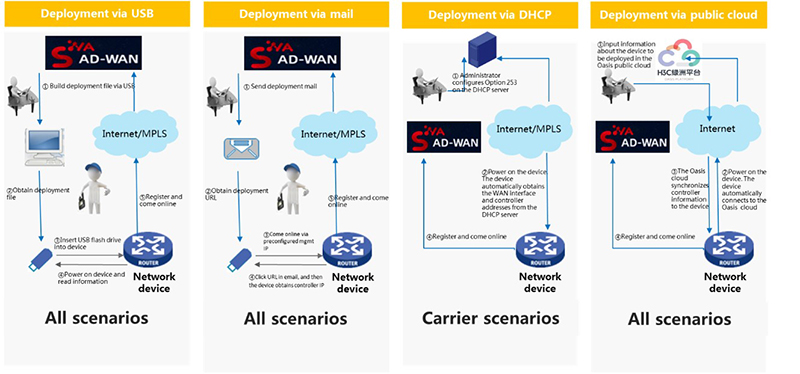
Service automation deployment
The H3C AD-WAN branch solution supports automatic delivery of VPN services, LAN services and QoS services across the entire network, supports application definition based on fields such as IP 5-tuple, DSCP, VPN, and application packet characteristics, supports optimal link requirements, bandwidth requirements, application quality requirements (delay, jitter, packet loss rate) and customize application policies, supports policy deployment based on a specified time period, and supports configuration through the AD-WAN interface with one-click.
• VPN service deployment: After the configuration-free launch, AD-WAN will automatically issue IPSEC tunnels according to whether the WAN interface type of the device is an Internet line or not. It also automatically overlays SD-WAN tunnels based on physical links to mask differences in branch access WAN network link types, providing the same scheduling capabilities on different links.
• LAN service deployment: For user's LAN side access network, user can conduct service pre-configuration and network planning on AD-WAN, and AD-WAN will automatically distribute LAN-side service configuration after the device comes online. Hence, there is no need to manually configure LAN-side service on a large number of branch devices. Branch-side CPE devices can be deployed as Layer 3 gateways within the branch. They can also be connected with Layer 3 networks within the branch using routing protocols.
• Simple QoS deployment: AD-WAN can apply the maximum bandwidth limit according to application groups, to limit the speed based on application groups. The speed limit configuration will be allocated to the LAN port of the device. When the bandwidth leased from the operator is less than the interface bandwidth, the speed limit can be configured directly at the WAN port of the device on the device management page to prevent the overflown traffic from being discarded directly at the operator. When the network is configured with the application traffic in multiple priorities in the network and there is congestion, users can configure the application guarantee policy in the application policy page to ensure low latency for the application traffic with higher priority. Different QoS queues and bandwidth percentages can be configured according to priority. Administrators can adjust the dynamic bandwidth speed limit based on real-time network conditions to ensure core network applications.
Intelligent traffic scheduling
H3C AD-WAN solution provides multiple scheduling strategies:
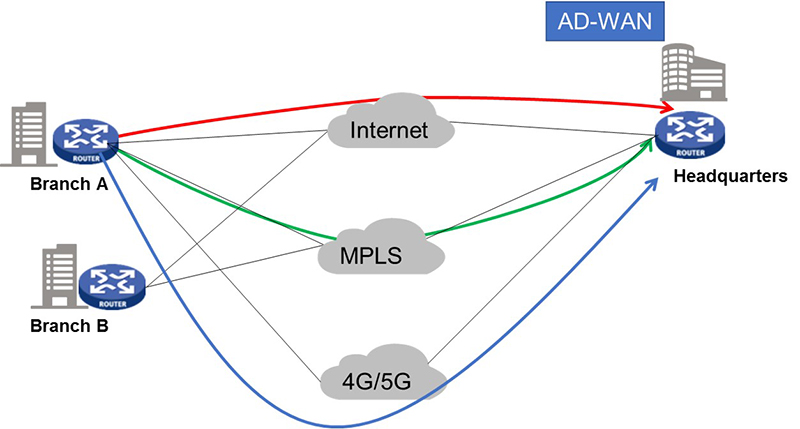
1. Based on the scheduling factors such as bandwidth utilization and link staining, assuming that two services are on the same link under normal conditions, as the link bandwidth utilization gradually increases, the device automatically schedules the abnormal link service to another high-quality link based on the corresponding scheduling policy issued by AD-WAN to guarantee the user's experience when the link utilization reaches the threshold.
• Based on delay, jitter, packet loss rate and other scheduling factors, assuming that two services are on the same link under normal circumstances, the device automatically schedules the abnormal link service to another high-quality link based on the corresponding scheduling policy issued by AD-WAN to ensure user experience when the delay of the link exceeds the threshold.
• Periodic service scheduling based on time period scheduling to achieve guaranteed scheduling of high-priority services within a certain time period for business to ensure business reliability requirements.
WAN acceleration
Web Cache and FEC technologies provide application-specific WAN acceleration and optimization.
• Web Cache: The device stores caches on the web page of the specified address accessed by the user through HTTP/HTTPS protocol locally, and responds directly from the local quickly when the user accesses the same content during the cache aging time. It increases the application download speed by 4 times and doubles the web page access efficiency.
• FEC: Through end-to-end link quality detection, Automatic Forward Error Correction automatically calculates and adjusts packet redundancy ratio based on real-time link packet loss rate to ensure a lower packet loss rate without sacrificing link bandwidth, which can significantly reduce the impact on real-time applications (video conferencing, voice telephony, etc.) caused by using low SLA level links such as the Internet.
Visualized monitoring and O&M
AD-WAN has various tools such as reports and big screen, helping O&M personnel check network status in time. For example, network visualization supports GIS map integration, including online and offline maps. Based on multiple topology presentation methods such as sites and links, it can obtain alarm or abnormal information immediately when network devices and links fail. The customized dashboard can adapt to the preferences and concerns of different operators. Secondly, it can display the status of the application, such as TopN application traffic display, application path display, and health degree, to help O&M staff learn about application operation status in real-time, and facilitate rapid fault positioning.
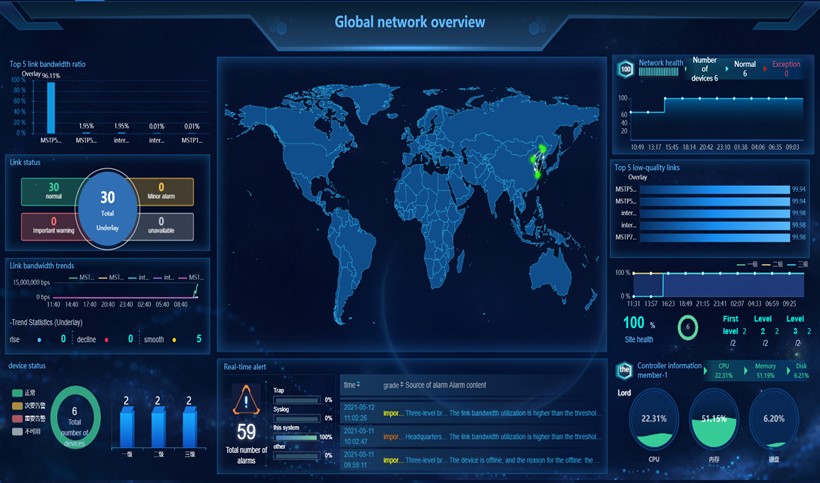
Complete set
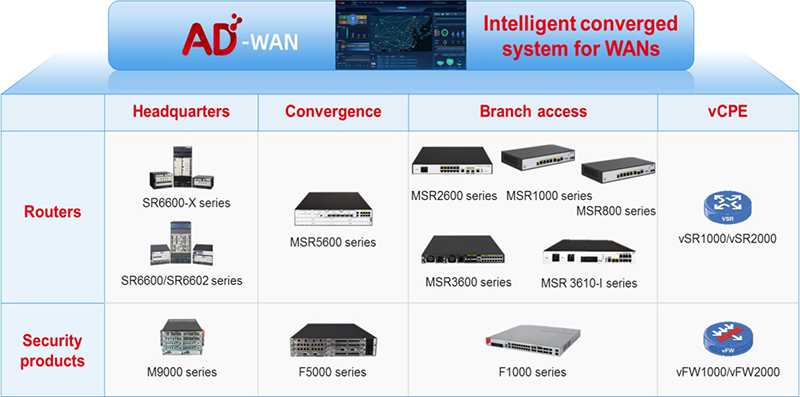
Typical networking
Scenario description:
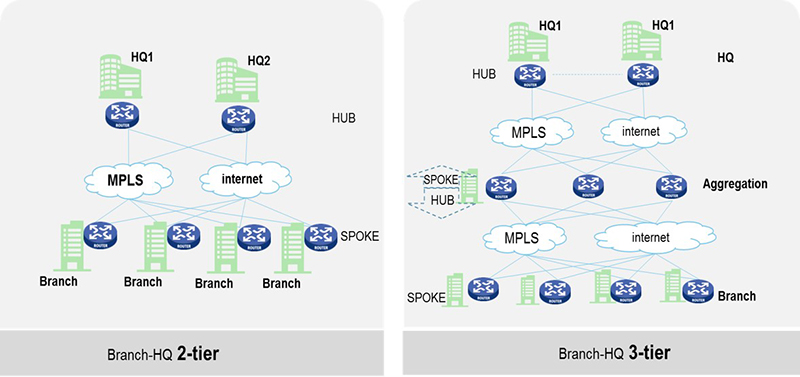
* It supports the common two-level Hub-Spoke network and the three-level architecture networking for large enterprises, supports mixed access of private and Internet links, and is suitable for enterprise networks with a large number of scattered branches.
* It mainly focuses on vertical traffic and realizes the distinction and identification of key enterprise services through ACL and DPI.
Functions
* Based on application scheduling of leased lines and Internet lines, different application traffic can go through different links according to quality, bandwidth and preferred path.
* The line bandwidth utilization is maximized, and line switching is supported to ensure the bearing of key services.
* When a link fails, it supports automatic control, which automatically redirects applications on the link.
* It supports multi-dimensional business visibility.
* It provides high forwarding, control, and management reliability.
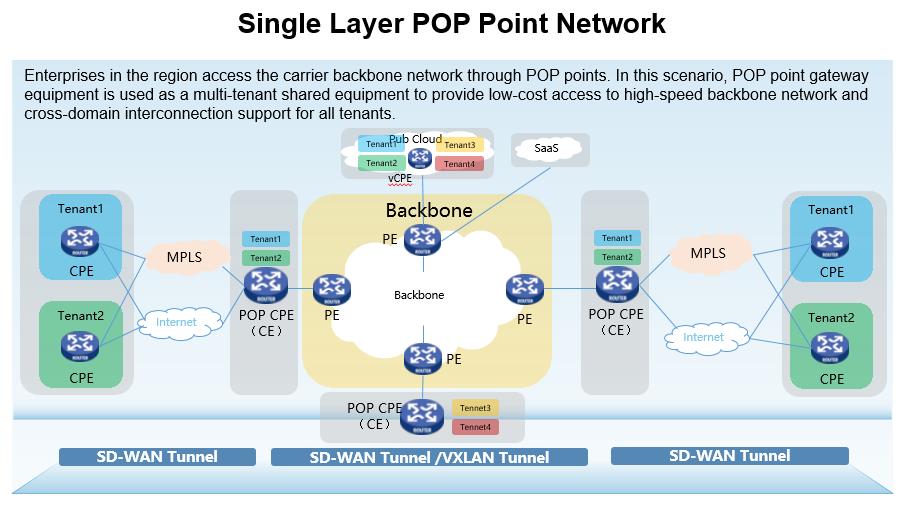

 Products and Solutions
Products and Solutions